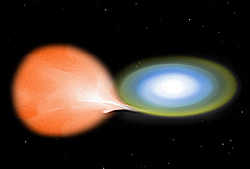
A nova is a transient astronomical event that causes the sudden appearance of a bright, apparently "new" star that slowly fades over weeks or months. Causes of the dramatic appearance of a nova vary, depending on the circumstances of the two progenitor stars. All observed novae involve white dwarfs in close binary systems. The main sub-classes of novae are classical novae, recurrent novae (RNe), and dwarf novae. They are all considered to be cataclysmic variable stars.

V1974 Cygni or Nova Cygni 1992 was a nova, visible to the naked eye, in the constellation Cygnus. It was discovered visually with 10×50 binoculars on February 19, 1992, by Peter Collins, an amateur astronomer living in Boulder, Colorado. At that time he first noticed it, it had an apparent magnitude of 7.2. Nine hours later he saw it again, and it had brightened by a full magnitude. For this discovery Collins was awarded the AAVSO Nova Award in 1993. The nova reached magnitude 4.4 at 22:00 UT on 22 February 1992. Images from the Palomar Sky Survey taken before the nova event showed identified a possible precursor which had photographic magnitudes of 18 and 17, but the identification of the precursor is not firm.

A nova remnant is made up of the material either left behind by a sudden explosive fusion eruption by classical novae, or from multiple ejections by recurrent novae. Over their short lifetimes, nova shells show expansion velocities of around 1000 km/s, whose faint nebulosities are usually illuminated by their progenitor stars via light echos as observed with the spherical shell of Nova Persei 1901 or the energies remaining in the expanding bubbles like T Pyxidis.

V1500 Cygni or Nova Cygni 1975 was a bright nova occurring in 1975 in the constellation Cygnus. It had the second highest intrinsic brightness of any nova of the 20th century, exceeded only by CP Puppis in 1942.
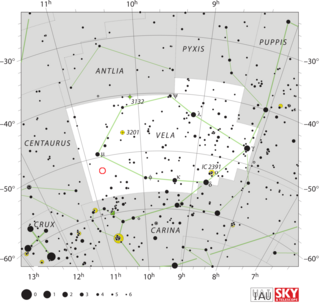
V382 Velorum, also known as Nova Velorum 1999, was a bright nova which occurred in 1999 in the southern constellation Vela. V382 Velorum reached a brightness of 2.6 magnitude, making it easily visible to the naked eye. It was discovered by Peter Williams of Heathcote, New South Wales, Australia at 09:30 UT on 22 May 1999. Later that same day it was discovered independently at 10:49 UT by Alan C. Gilmore at Mount John University Observatory in New Zealand.

T Aurigae was a nova, which lit up in the constellation Auriga in 1891. Thomas David Anderson, an amateur astronomer in Edinburgh, reported that he was "almost certain" he saw the nova at 02:00 UT on 24 January 1892, when it was slightly brighter than χ Aurigae. He mistook the star for 26 Aurigae, although he noted to himself that it seemed brighter than he remembered it being. He saw it twice more during the following week. On 31 January 1892 he realized his mistake, and wrote a note to Ralph Copeland reporting his discovery. Professor Copeland immediately reported the discovery via telegram to William Huggins, who made the first spectroscopic observations of T Aurigae on 2 February 1892, when the star was a magnitude 4.5 object. T Aurigae was the first nova to be observed spectroscopically.

HR Lyrae or Nova Lyrae 1919 was a nova which occurred in the constellation Lyra in 1919. Its discovery was announced by Johanna C. Mackie on 6 December 1919. She discovered it while examining photographic plates taken at the Harvard College Observatory. The bulletin announcing the discovery states "Between December 4 and 6 it rose rapidly from the sixteenth magnitude or fainter, to a maximum of about 6.5". It was the first nova ever reported in Lyra, and Mackie was awarded the AAVSO gold medal for her discovery. Its peak magnitude of 6.5 implies that it might have been visible to the naked eye, under ideal conditions.

V533 Herculis was a nova visible to the naked eye, which occurred in 1963 in the constellation of Hercules.

NQ Vulpeculae also known as Nova Vulpeculae 1976, was a nova that appeared in the constellation Vulpecula in 1976. It was discovered visually at 18:20 UT on October 21, 1976 by English amateur astronomer George Alcock. Its apparent magnitude at the time of discovery was 6.5 It reached its maximum brightness of magnitude 6.0 thirteen days after its discovery, at which point it may have been faintly visible to the naked eye. A few days after maximum brightness, it had faded to magnitude 8.3.

V1668 Cygni was a nova that appeared in the northern constellation of Cygnus, situated a couple of degrees to the southeast of the star Rho Cygni. It was discovered by Canadian variable star observer Warren Morrison on September 10, 1978, and reached a peak brightness of around 6.22 apparent magnitude on September 12. The luminosity of the source at this time was about 100,000 times the brightness of the Sun, and likely remained at that level for several months. The expansion velocity of the nova shell was deduced through spectroscopy to be 1,300 km/s.

DK Lacertae was a nova, which lit up in the constellation Lacerta in 1950. The nova was discovered by Charles Bertaud of the Paris Observatory on a photographic plate taken on 23 January 1950. At the time of its discovery, it had an apparent magnitude of 6.1. DK Lacertae reached peak magnitude 5.0, making it easily visible to the naked eye.
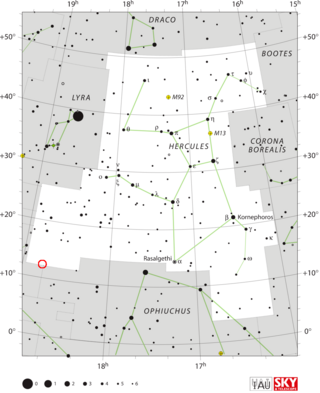
V838 Herculis, also known as Nova Herculis 1991, was a nova which occurred in the constellation Hercules in 1991. It was discovered by George Alcock of Yaxley, Cambridgeshire, England at 4:35 UT on the morning of 25 March 1991. He found it with 10×50 binoculars, and on that morning its apparent visual magnitude was 5. Palomar Sky Survey plates showed that before the outburst, the star was at photographic magnitude 20.6 and 18.25.
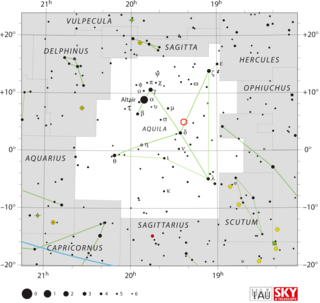
V1494 Aquilae or Nova Aquilae 1999 b was a nova which occurred during 1999 in the constellation Aquila and reached a brightness of magnitude 3.9 on 2 December 1999. making it easily visible to the naked eye. The nova was discovered with 14×100 binoculars by Alfredo Pereira of Cabo da Roca, Portugal at 18:50 UT on 1 December 1999, when it had a visual magnitude of 6.0.

SS Cygni is a variable star in the northern constellation Cygnus. It is the prototype of the subclass of dwarf novae that show only normal eruptions. It typically rises from 12th magnitude to 8th magnitude for 1–2 days every 7 or 8 weeks. The northerly declination of SS Cygni makes the star almost circumpolar from European and North American latitudes, allowing a large proportion of the world's amateur astronomers to monitor its behavior. Furthermore, since the star lies against the rich backdrop of the Milky Way band, the telescope field of view around SS Cygni contains an abundance of useful brightness comparison stars.
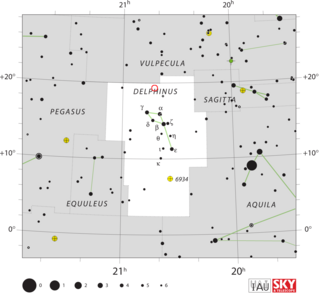
HR Delphini, also known as Nova Delphini 1967, was a nova which appeared in the constellation Delphinus in 1967. It was discovered by George Alcock at 22:35 UT on 8 July 1967, after searching the sky for over 800 hours with binoculars. At the time of discovery it had an apparent magnitude of 5.0. It reached a peak brightness of magnitude 3.5 on 13 December 1967, making it easily visible to the naked eye around that time. Pre-outburst photographs taken with the Samuel Oschin telescope showed it as a ~12th magnitude star which might have been variable.
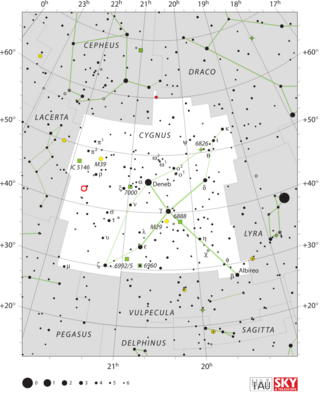
Q Cygni, is a star located in the constellation Cygnus. It is also known as Nova Cygni 1876, and has the designation NGC 7114, and HR 8296. Nova Cygni is located in the northwestern portion of Cygnus along the border with Lacerta.

V1331 Cygni is a young star in the constellation Cygnus. V1331 Cyg is located in the dark nebula LDN 981.

YZ Reticuli, also known as Nova Reticuli 2020 was a naked eye nova in the constellation Reticulum discovered on July 15, 2020. Previously it was known as a VY Sculptoris type object with the designation MGAB-V207.
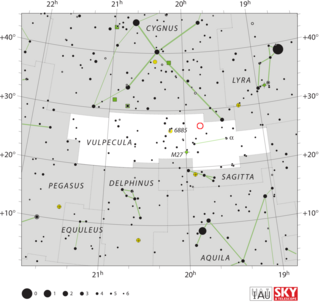
LV Vulpeculae, also known as Nova Vulpeculae 1968 no. 1, was the first of two novae in the constellation of Vulpecula which erupted in 1968. It was discovered by George Alcock who observed it from the back garden of his home in Farcet, England, on the morning of 15 April 1968. The next night it was independently discovered by Midtskoven in Norway. It reached a peak apparent magnitude of 4.79 on 17 April 1968. It was visible to the naked eye at the same time HR Delphini was a naked eye object, and the two novae were less than 15 degrees apart on the sky.

OY Arae, also known as Nova Arae 1910, is a nova in the constellation Ara. It was discovered by Williamina Fleming on a Harvard Observatory photographic plate taken on April 4, 1910. At that time it had a magnitude of 6.0, making it faintly visible to the naked eye under ideal observing conditions. Examination of earlier plates showed that before the outburst it was a magnitude 17.5 object, and by March 19, 1910, it had reached magnitude 12.























